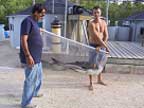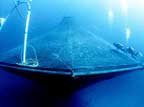NOAA Mission Goal:
To protect, restore, and manage the use of coastal and ocean resources through an ecosystem approach to management

Cobia broodstock in the Florida Keys.

Submerged cage used in offshore aquaculture research.
NOAA Mission Goal:
To protect, restore, and manage the use of coastal and ocean resources through an ecosystem approach to management

Cobia broodstock in the Florida Keys.

Submerged cage used in offshore aquaculture research.
NOAA requests $1.6M for the NOAA Marine Aquaculture Program to promote sustainable aquaculture with support for projects that field-test new environmentally compatible production systems and provide aquaculture information to the public. These projects will lead to technical developments in genetics, nutrition, disease, hormone manipulation, biotechnology, and mitigation of environmental impacts. In addition, the Program will develop collaborative studies with international partners on ecosystem effects and carrying capacities for coastal ecosystems.
Each year, the U.S. currently imports over $10 billion, or 60%, of its seafood. Seafood ranks second only to oil among natural products imported. At the same time, over-fishing has depleted several important wild fish stocks, putting U.S. fishermen and seafood processors out of business. Marine aquaculture has the potential to provide up to 50% of our seafood within the next 20 years and provide the seed for rebuilding wild stocks.
The NOAA Marine Aquaculture Program initiative promotes an environmentally friendly and profitable industry that will reduce our Nation's reliance on imported seafood while also improving ecological function. The recommendations in the U.S. Commission on Ocean Policy's 2004 report reaffirm the importance of NOAA's aquaculture programs. It calls for NOAA to be the lead federal agency to ensure the development of an economically and environmentally sound marine aquaculture industry.
Near-shore and offshore aquaculture, which are controlled cultivation of marine organisms, are critical components of NOAA's ecosystem management plans and will benefit both wild stocks and water quality. As the production of cultivated fish increases, pressure could be reduced on wildstock fisheries. Associated economic benefits of such production include increased employment and continued protection of the health of the commercial fishing and recreational fisheries industries. Moreover, s trategic placement of filter-feeding aquaculture organisms, which reduce human-related excess nutrients, is an emerging method that uses aquaculture to improve water quality in natural habitats.
What: $1.6M Total
Why: To ensure the development of an economically and environmentally sound
marine aquaculture industry in the U.S. to meet our Nation's growing appetite
for seafood.
Office of Oceanic & Atmospheric Research, Ocean, Coastal and Greal Lakes Research, Other Partnership Programs
Recent technological advances are making aquaculture an increasingly safe and profitable industry. Projects funded by the initiative will help lead this industry to become an environmentally sustainable, commercial-scale, domestic source for meeting the increasing demand for seafood in the American diet. Aquaculture technologies, consulting services for private industry, and efforts to enhance wild fisheries, as well as superior, disease-free or resistant strains of broodstock are valuable exports that contribute to the U.S. economy.
NOAA Research will implement a nationally competitive grants program managed by the National Sea Grant College Program. The program will fund aquaculture research for new technologies, including offshore, near-shore, and re-circulating aquaculture systems, as well as enhanced wild fisheries stock programs. NOAA's aquaculture education and extension network will be maintained, facilitating the transfer of research into business operations, as well as informing the public about key issues and information related to aquaculture.
The NOAA aquaculture program grew out of and is complemented by the Sea Grant College Program's research and outreach activities. In FY 2001, NOAA received 222 proposals totaling $92 million in research initiatives in a competition for $5 million in available funds. Seven of the 23 projects funded had an offshore technology component. In the last three years, NOAA has continued to receive a large number of high quality aquaculture proposals. Regional partnerships between NOAA and the external community have already been established in the Gulf Coast, Pacific Northwest, Hawaii/Pacific regions, and Florida and Puerto Rico. The FY 2006 requested increase will strengthen aquaculture research in these regions.
The NOAA Marine Aquaculture Program is poised to:
OAA Research investments through the National Sea Grant College Program have helped establish scores of new businesses throughout the nation and provided technologies to these businesses. The combined impact of Sea Grant-developed technology amounts to at least $100 million annually and supports thousands of jobs in the U.S. economy. Within the last five years, NOAA';s National Sea Grant College Program has conducted aquaculture research, education, and outreach activities that have achieved controlled spawning of species that could not previously be cultured, improved feeding methods to reduce negative impacts from wastewater discharges, and accomplished commercial-scale growout of cobia and moi fishes in offshore cages. The requested funds would enable NOAA to continue and expand these development efforts.

For more information:
NOAA Research
External Affairs Team
301.713.1671
Marine Aquaculture Initiative
$ 1.6M Total
Office of Oceanic & Atmospheric Research, Ocean, Coastal and Greal Lakes Research, Other Partnership Programs
March 2, 2005